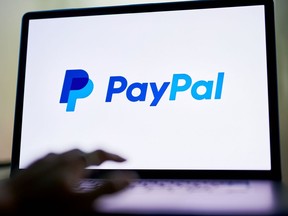PayPal Holdings Inc. has expanded its network of partnerships by aligning with Shopify Inc., signing a deal to process a portion of PayPal’s debit- and credit-card transactions. In this collaboration, PayPal’s digital wallet will be integrated with Shopify Payments, reinforcing the strategic tie between the two fintech and e-commerce platforms. The alliance follows a prior joint effort two years ago to introduce Shopify Payments in France, signaling a continuing push to streamline payment options for merchants on Shopify’s platform while broadening PayPal’s reach across merchant ecosystems. The move occurs in a broader industry context where PayPal is actively reshaping its offerings and partnerships to sustain long-term growth amid competitive pressure from other payments processors. The broader implications extend to merchants seeking simplified settlement flows, customers seeking smoother checkout experiences, and investors watching how PayPal positions itself against larger players in the payments space.
Partnership Details and Scope
PayPal’s latest partnership with Shopify marks a notable expansion of the two companies’ collaboration, specifically focusing on creating a more seamless payment experience for merchants and customers alike. The core element of the deal centers on integrating PayPal’s digital wallet with Shopify Payments, Shopify’s own payment processing platform. This integration means that merchants using Shopify’s checkout flow will be able to accept PayPal wallet payments through the Shopify ecosystem, thereby broadening the range of payment options available at the point of sale. In practical terms, merchants can offer PayPal as a payment method within their Shopify-powered storefronts, leveraging PayPal’s customer base and familiar checkout experience while benefiting from Shopify Payments’ built-in reconciliation, settlement, and processing capabilities. The arrangement is designed to reduce the friction often associated with multi-provider checkout flows, enabling merchants to capture PayPal-driven transactions without leaving the Shopify Payments environment. The overarching aim is to create a more cohesive and efficient payment experience that benefits merchants by simplifying cash flow, improving settlement timing, and potentially reducing the administrative burden of managing multiple payment partners.
The historical context of this partnership includes a prior collaboration two years earlier, when the two companies worked together to introduce Shopify Payments in France. That earlier effort laid a foundation for this expanded alliance by validating the viability of PayPal’s wallet in conjunction with Shopify’s payment infrastructure in a European market. Building on that foundation, the new agreement extends the integration more broadly, signaling a commitment to deeper interoperability between PayPal’s wallet and Shopify’s payment rails. By leveraging Shopify’s established merchant network and PayPal’s widespread consumer wallet, the collaboration seeks to enhance checkout simplicity and broaden the appeal of PayPal as a payment option within Shopify’s ecosystem. The integration is also likely to involve alignment on risk controls, fraud prevention, and settlement workflows to ensure that the combined solution meets the rigorous standards expected by merchants and financial regulators alike.
From a merchant perspective, the partnership is expected to deliver several tangible benefits. First, it provides an additional, trusted pathway for accepting PayPal wallet payments within Shopify’s unified payments environment, potentially improving conversion rates for merchants who already rely on PayPal heavily. Second, it reduces complexity by enabling PayPal transactions to be processed through Shopify Payments, which can simplify reconciliation and reporting for store owners who manage multiple sales channels. Third, the collaboration may unlock cross-selling and retention opportunities, as customers who prefer PayPal’s wallet can complete transactions more quickly, ultimately affecting customer satisfaction and repeat purchase behavior. The exact fee structure and per-transaction economics of the integration were not disclosed in the public statements, but industry observers typically expect negotiations around processing rates, settlement timing, and potential incentives for larger merchants to adopt the combined solution. The absence of explicit pricing details leaves room for future announcements as the partnership matures and as merchants begin to adopt the new capability.
In addition to the immediate benefits of payment acceptance, the partnership underscores Shopify’s broader strategy to diversify payment options within its ecosystem while strengthening PayPal’s visibility among Shopify merchants. For Shopify, the integration reinforces the value proposition of Shopify Payments by expanding card and wallet acceptance options without forcing merchants to juggle multiple providers or separate checkout experiences. For PayPal, the deal represents a strategic foothold within an increasingly competitive market where providers are vying for merchant lock-in and customer loyalty. The collaboration aligns with PayPal’s ongoing strategy to broaden its enterprise footprint through partnerships that complement its wallet-centric growth model while leveraging Shopify’s expansive merchant base and adoption of online storefronts around the world. In practice, the partnership illustrates a growing trend in the payments space toward platform-level interoperability, where wallets, cards, and alternative payment methods are coordinated within single merchant ecosystems to deliver a frictionless checkout experience.
Integration Roadmap and Operational Considerations
Although the public releases do not disclose a granular project timeline, the expected integration roadmap likely encompasses several key phases. Initially, technical work would focus on establishing secure and compliant interfaces between PayPal Wallet and Shopify Payments, including authentication, tokenization, and fraud-prevention controls that work across Shopify’s checkout flows. Following that groundwork, testing with select pilot merchants would be critical to validate the reliability of PayPal wallet transactions within Shopify’s infrastructure, ensuring that settlement reporting aligns with merchants’ expectations and that PayPal wallet funding sources are correctly reconciled within Shopify’s financial ecosystem. Once validation is complete, a broader rollout would be pursued, expanding access to the integration across Shopify’s merchant community. Throughout this process, the teams would collaborate to address regional regulatory considerations, currency handling, and risk controls tailored to different markets, ensuring that the integrated payment experience remains consistent and secure for customers worldwide.
In terms of user experience, the merged solution is expected to maintain a streamlined checkout experience, with PayPal wallet customers able to select PayPal at checkout and complete purchases using funds stored in their PayPal wallets, while merchants continue to benefit from Shopify Payments’ streamlined settlement cycles. Merchants may also enjoy enhanced reconciliation workflows, consolidated reporting, and the potential for a more unified customer data profile that spans PayPal wallet activity and Shopify transaction data. While the exact user interface changes are not detailed in public statements, the overarching aim of the integration is to minimize checkout friction, reduce payment abandonment, and provide a more cohesive and reliable payment experience for shoppers on Shopify storefronts.
Strategic Direction Under CEO Alex Chriss
The partnership with Shopify is part of a broader strategic shift under PayPal chief executive Alex Chriss, who is steering the company toward renewed emphasis on long-term profitable growth. Chriss has signaled a transformation of PayPal’s organizational structure and strategy, stating that he aims to return the company to “long-term profitable growth” and to address what he described as a bloated corporate posture that had emerged after several acquisitions. The leadership changes and strategic realignment are intended to sharpen focus on core strengths while seeking opportunities to improve efficiency, innovate more rapidly, and respond more effectively to the evolving payments landscape. Under this vision, partnerships like the one with Shopify are viewed as critical levers to accelerate innovation and expand PayPal’s reach across the merchant ecosystem.
Chriss has articulated a belief in the power of collaboration as a driver of industry progress. He has emphasized that working closely with merchants and partners accelerates problem solving and enables faster innovations that benefit customers. The CEO’s messaging suggests a deliberate pivot away from complex, multi-year consolidation efforts toward simpler, more outcome-driven initiatives that deliver tangible value to users and merchants. In practical terms, this means a push to streamline product portfolios, reduce inefficiencies associated with legacy systems, and allocate resources toward initiatives with clear, measurable impact on user experience, security, and performance. The shift also signals a broader industry trend where leadership at major fintechs is increasingly measured by the speed and effectiveness of partnerships that unlock seamless cross-platform capabilities and broaden the available options for merchants and consumers.
The leadership restructuring accompanying Chriss’s strategy includes the revamping of management ranks and pruning what he described as bloated assets resulting from a wave of acquisitions in the recent past. While specifics about which units were reorganized or eliminated were not disclosed, the overarching intent is clear: optimize the company’s operating model to support sustainable growth. This approach aligns with the broader objective of returning PayPal to a growth trajectory that emphasizes profitability and efficiency, rather than relying solely on inorganic expansion through acquisitions. The emphasis on collaboration with merchants, however, points to a continued commitment to expanding PayPal’s ecosystem through partnerships that enhance the practical utility of PayPal’s wallet and related services for merchants and consumers alike.
In this context, the Shopify partnership can be viewed as a strategic test case for the effectiveness of PayPal’s renewed operating model. By integrating with a major e-commerce platform, PayPal has the opportunity to demonstrate the value of its wallet within a large, merchant-centric environment. The success of this collaboration could influence future partnership strategies, inform product roadmaps, and shape how PayPal positions its wallet against other payment rails in a rapidly evolving market. Additionally, the market response to Chriss’s restructuring—both in terms of investor sentiment and merchant adoption—will likely provide signals about the viability of the broader strategic shift toward long-term profitability and streamlined operations.
Competitive Landscape and Industry Context
PayPal’s expanded partnership with Shopify arrives at a moment when the payments-processing landscape is highly competitive and characterized by multiple players striving for broader merchant adoption. PayPal faces competition from established processors like Adyen NV and Stripe Inc., each offering robust platforms for merchants to handle card-present and online transactions, along with a suite of value-added services such as risk management, analytics, and cross-border capabilities. The company’s ongoing strategy includes strengthening relationships with merchants and partners to secure a larger share of transaction volume and enhance the value proposition of its wallet in enterprise settings. Recent moves, including partnered arrangements with Adyen and Fiserv Inc., indicate PayPal’s intention to diversify and deepen its merchant ecosystem, aligning with the broader industry trend toward multi-provider flexibility and platform-level interoperability.
For Shopify, integrating PayPal Wallet within Shopify Payments complements its broader objective of offering merchants a seamless, end-to-end payments experience within a single platform. This approach aligns with Shopify’s emphasis on reducing complexity for merchants, improving checkout conversion, and delivering reliable settlement and reporting. The partnership with PayPal also diversifies payment options for Shopify merchants, potentially increasing adoption rates among diverse merchant segments who rely on PayPal for consumer transactions or for cross-border sales where PayPal’s global reach can be advantageous. The evolving competitive environment, marked by collaborations, acquisitions, and rapid product enhancements, underscores the importance of strategic partnerships that can deliver tangible operational efficiencies and better customer experiences.
Industry observers note that the payments-processing market is closely tied to consumer behavior, e-commerce growth, and the maturation of digital wallets. Customers increasingly expect flexible payment methods, fast settlement, and secure transactions, all of which can be enhanced through the integration of wallet-based payments within established e-commerce platforms. In this context, PayPal’s collaboration with Shopify is not simply a transactional arrangement; it represents a broader attempt to position PayPal as a core component of modern online commerce infrastructure. The success of this strategy will depend on how well PayPal can optimize the user experience, manage risk, and maintain high levels of reliability across a wide array of devices, geographies, and regulatory environments.
Implications for Merchants and Consumers
From a merchant perspective, the PayPal-Shopify integration offers meaningful potential benefits. Merchants could experience smoother reconciliation as transactions processed through PayPal Wallet appear within the Shopify Payments framework, reducing the administrative effort required to manage multiple payment gateways. The increased flexibility in payment options can also support higher conversion rates, as customers who prefer PayPal can complete transactions without navigating away from the checkout flow. The integrated solution could simplify reporting and analytics, allowing merchants to gain deeper insights into buying patterns, payment method performance, and customer preferences across PayPal Wallet and Shopify’s platform. These advantages are particularly relevant for merchants operating in markets where PayPal remains a leading method of payment, or where PayPal’s wallet is popular among consumers who value speed and security at checkout.
For consumers, the enhanced payment experience promises quicker, more familiar checkout processes when shopping on Shopify-powered stores that support PayPal Wallet. Shoppers who already maintain PayPal wallets could enjoy streamlined payment flows, reduced friction at checkout, and the assurance of PayPal’s established security and buyer protection capabilities. The broader availability of PayPal Wallet through Shopify could also translate into more consistent payment experiences across merchant storefronts, particularly for customers who shop across multiple stores using Shopify’s platform. While some merchants might assess fee implications or preference for other payment methods, the partnership is designed to deliver a more harmonious checkout ecosystem that aligns with contemporary consumer expectations for ease of use and reliability.
In addition to the direct effects on checkout experiences, the partnership reflects ongoing industry trends toward interoperability and platform-level collaborations. Merchants increasingly expect that wallets, cards, and alternative payment methods can be integrated within a single, coherent system that supports fast settlement, strong security, and actionable data insights. The PayPal-Shopify collaboration is a concrete example of how a leading wallet and a major e-commerce platform can synchronize their capabilities to deliver a more seamless, efficient, and user-friendly payment experience. If successful, the partnership could set a precedent for similar integrations across other platforms and wallets, encouraging broader ecosystem alignment that benefits merchants, customers, and developers working on payment solutions.
Historical Context and Regional Deployment
The PayPal-Shopify partnership builds on prior collaboration that included a France-based rollout of Shopify Payments, illustrating an earlier regional test bed for the integration of PayPal’s wallet with Shopify’s payments infrastructure. The France deployment served as an early proof point for the viability of PayPal Wallet within the Shopify ecosystem, informing subsequent expansion plans beyond that initial market. This historical context helps illuminate the strategic logic behind the broader partnership, suggesting that PayPal’s wallet integration is part of a deliberate effort to integrate PayPal’s payments capabilities into a larger merchant platform with global reach. The France experience likely contributed valuable lessons regarding regulatory compliance, regional payment preferences, and merchant adoption dynamics, all of which could inform future rollout strategies across other regions with varying regulatory landscapes and consumer behavior patterns.
In the broader history of PayPal’s corporate strategy, partnerships with major payment rails and fintech platforms have been a recurring theme as the company seeks to diversify its distribution channels and reduce dependency on any single revenue stream. The Shopify collaboration is consistent with a long-running emphasis on expanding PayPal’s reach by embedding its wallet within trusted e-commerce ecosystems, thereby increasing transaction volumes and reinforcing PayPal’s role as a flexible, consumer-friendly payment method. For Shopify, the alliance aligns with the platform’s strategy to offer merchants a comprehensive suite of payments options and a simplified, end-to-end merchant experience that reduces complexity and helps drive growth. The France experience, coupled with the new broader integration, reflects a methodical, phased approach to expanding PayPal Wallet’s presence within major e-commerce ecosystems while carefully managing regulatory and operational considerations.
Future Outlook and Strategic Implications
Looking ahead, the PayPal-Shopify partnership could serve as a proving ground for how effectively wallet-based payments can be integrated into large-scale e-commerce platforms without compromising speed, security, or user experience. If the integration demonstrates strong performance in terms of reliability, reconciliation efficiency, and merchant satisfaction, additional expansions could follow, potentially including deeper data-sharing capabilities (within privacy constraints), enhanced fraud prevention features, and expanded availability across more markets. The success metrics for this partnership may include merchant adoption rates, transaction volume through PayPal Wallet on Shopify, and improvements in checkout conversion for stores that opt into the integrated solution. Moreover, the collaboration could influence PayPal’s broader product roadmap by highlighting the operational and customer-experience benefits of wallet integration within an established commerce ecosystem.
From an industry standpoint, this partnership underscores a broader trend toward cross-platform interoperability in payments. As merchants seek unified experiences for customers and simplified financial workflows, more collaborations between wallets, card networks, and merchant platforms could emerge. The PayPal-Shopify collaboration could act as a bellwether, encouraging other wallet providers to pursue similar integrations with leading e-commerce platforms, potentially reshaping the competitive dynamics among payment processors. For investors and market participants, the partnership is a signal of PayPal’s ongoing strategic pivot toward more collaborative, ecosystem-focused growth initiatives that emphasize profitability and scalable operations while maintaining a strong emphasis on customer protection and trust. The broader implications for the industry include heightened competition among large players to secure merchant footprints through integrated solutions, as well as increased attention on how such partnerships affect merchant margins, consumer choice, and the speed of payments processing across global markets.
Conclusion
The expansion of PayPal’s partnership with Shopify to integrate PayPal Wallet within Shopify Payments represents a strategic effort to deepen interoperability between a leading digital wallet and a major e-commerce payments platform. By enabling merchants to accept PayPal wallet transactions through Shopify Payments, the collaboration aims to streamline reconciliation, broaden payment acceptance options, and enhance the checkout experience for both merchants and customers. The alliance builds on a prior France rollout and aligns with PayPal’s broader strategic shift under CEO Alex Chriss toward long-term profitable growth, organizational optimization, and renewed emphasis on collaboration with merchants and partners to accelerate innovation. In the highly competitive payments landscape, the partnership positions PayPal to challenge rivals such as Adyen and Stripe while expanding its footprint through platform-level integrations that deliver practical value to merchants. Looking ahead, success will hinge on the integration’s reliability, the speed at which merchants adopt the new capability, and the degree to which the combined solution can deliver measurable improvements in conversion, reconciliation, and customer satisfaction.



